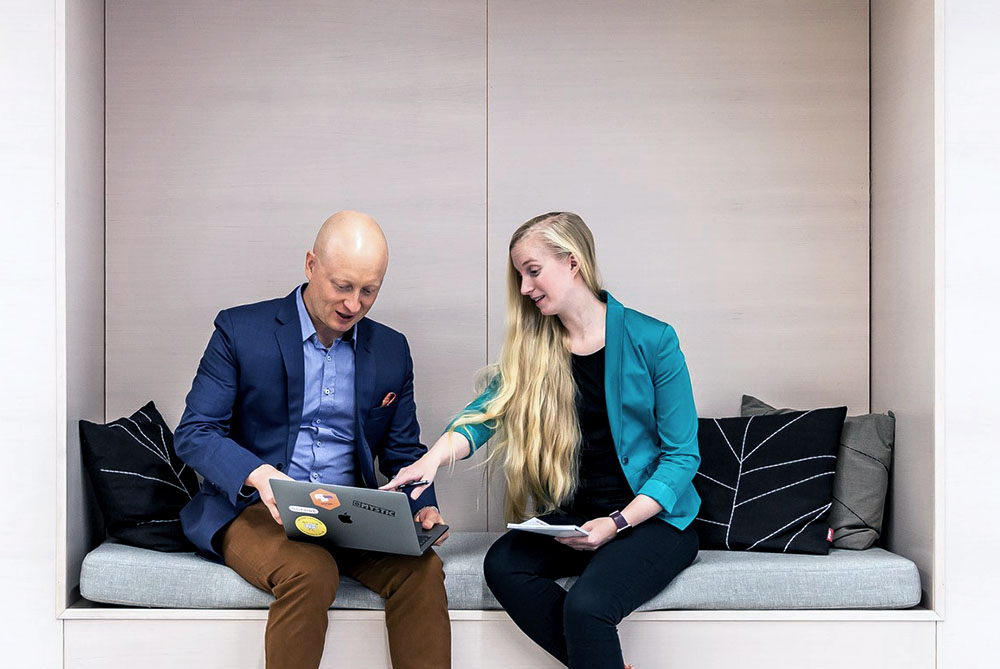Generative AI, machine learning, and the utilisation of large data sets offer numerous possibilities for the design and implementation of interfaces, which were previously too time-consuming or expensive.
A significant paradigm shift is occurring in interface design due to AI. Originally, computers were operated with punch cards without interaction, then moved to a more interactive step-by-step command approach. We are now approaching an outcome-driven method, where the user tells the computer what they want, and then refines the outcome through feedback.
Read more about this on Jakob Nielsen’s AI Paradigm Shift blog post or in a post of mine in Yle News Lab’s blog.
Start with experiments
The great new opportunity in AI application design is that the interface of AI applications can be highly adaptive. Until now, a skilled designer has meticulously planned almost all views of an application. In an AI-centric application, this is not practical because the human-computer interaction will evolve in a more conversational and nuanced direction, where it’s possible to also use other types of interaction than a chat-type interface.
Designers are experts in organising experiments, discovering user needs, and envisioning processes. Most users are not interested in tweaking settings; they expect applications to “just work.” This leads to the need to find new ways to learn which features users value at any given time. To date, the most visible adopters of personalisation and recommendations have been found among media services.
The experiences gathered from experiments must be articulated into understandable parts of an organisation’s AI strategy—we are not conducting a standalone study, but expanding the entire customer experience.
Qualitative research methods lay the groundwork for the following development phases.
Innovating new use-cases moves us forward
Openness and transparency about the use of AI are important when building trust with the user in an application. The way the user is addressed, interaction methods, and the consistency of the service experience are key factors in forming trust.
Highly personalised services generate more value for their users, it streamlines activities, and enhances functions and performance. Understanding users’ thought patterns is therefore of primary importance for AI to be helpful in these functions. Studying and modelling behaviour patterns and processes play a large role in preparing for how AI assistants could be utilised.
Practically, technology does not limit the possibilities of implementation, so understanding people’s wishes, needs, and expectations is central. The user experience must be built to match the feeling of a personalised service.

System designers and user experience designers must be able to envision what users want to achieve. The availability of “quite good”, credible results from a GPT assistant might easily blind the user to lose focus from the original task. This is a new cognitive challenge, where we are in a fascinating in-between of convergence and divergence. Managing user expectations, comprehending and structuring the overall situation, is highly significant in forming the service experience.
This is a learning process for the entire organisation, starting with the users.
In the workshops we lead, we always ensure that everyone feels confident and secure to transition into considering their role in future processes. Unprejudiced experimentation and the learning from it, opens the necessary pathways for understanding the correct directions for development.
The future user experience will be hybrid for quite a while
We are only at the beginning of the process, and interface design models are still largely based in another paradigm era. The future will be hybrid for a long time, with devices with screens and buttons that require continuous guidance, but, also with gradually more prevalent self-sufficient AI solutions.
No one can fully envision the future we will develop. We cannot predict it either, but we can give ourselves good opportunities to succeed by preparing well.
It is important to start working with these questions:
- What user problems could we solve with AI, and which parts of the user journey could benefit from AI solutions?
- How do we serve both the curious experimenters and the ones who are content with just basic features?
- How do we create a sense of security and trust in new services?
- How should the application’s user experience be shaped?
- How do we keep the whole ethical and sustainable?
Gofore’s Design & AI team researches and develops user-centric interface design – understanding the possibilities of AI. The team’s objective is to support and inspire our digital society and intelligent industry customers to find interesting beginnings within future user experience development, and, nurture these toward the adoption of useful and purposeful AI-assisted applications.
Experimental workshops with a safe atmosphere, participatory methods, and understanding the evolution of service design, are good ways to get organisational change underway.
Let’s be in touch!
P.S. Take a peek at Gofore’s design services – what we could we not achieve together!



